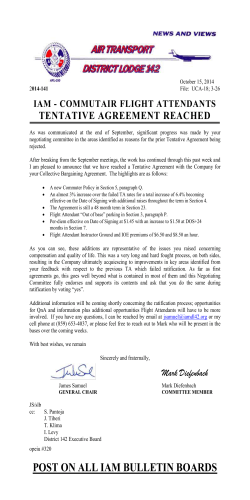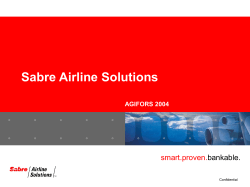
FOI MANUAL PART II – OPERATIONAL DEMONSTRATIONS, VOL 2 Page - 254
FOI MANUAL PART II – OPERATIONAL DEMONSTRATIONS, INSPECTIONS, APPROVALS AND SURVEILLANCE MANUAL VOL 2 Page - 254 APPENDIX 2 ORGANIZATION AND CONTENTS OF AN OPERATIONS MANUAL CHECKLIST FOS FORM CL-107-OM Issue 2: January 2014 FOR 1 OPS MANUAL REFERENCE GENERAL 1.1 Instructions outlining the responsibilities of operations personnel pertaining to the conduct of flight operations. 1.2 (a) Rules limiting the flight time and flight duty periods and providing for adequate rest periods for flight crewmembers and cabin crew. (b) Policy and documentation pertaining to FRMS. 1.3 A list of the navigational equipment to be carried including any requirements relating to operations where Performance Based Navigation is prescribed. 1.4 Where relevant to the operations, the long-range navigation procedures, engine failure procedure for ETDO and the nomination and utilization of diversion aerodromes. 1.5 The circumstances in which a radio listening watch is to be maintained. 1.6 The method for determining minimum flight altitudes. 1.7 The methods for determining aerodrome operating minima. SECOND EDITION February 2014 CIVIL AVIATION AUTHORITY OF NEPAL For CAAN use Sat/Unsat. Inspector’s Initials FOI MANUAL PART II – OPERATIONAL DEMONSTRATIONS, INSPECTIONS, APPROVALS AND SURVEILLANCE MANUAL FOR 1.8 Safety precautions during refuelling with passengers on board. 1.9 Ground handling arrangements and procedures. 1.10 Procedures for pilots-in-command in observing an accident. 1.11 The flight crew for each type of operation including the designation of the succession of command. 1.12 Specific instructions for the computation of the quantities of fuel and oil to be carried, having regard to all circumstances of the operation including the possibility of the failure of one or more engines while en-route. 1.13 The conditions under which oxygen shall be used and the amount of oxygen determined in accordance with the FOR requirements. OPS MANUAL REFERENCE 1.14 Instructions for mass and balance control. 1.15 Instructions for the conduct and control of ground de-icing/anti-icing operations. 1.16 The specifications for the operational flight plan. 1.17 Standard operating procedures (SOP) for each phase of flight. 1.18 Instructions on the use of normal checklists and the timing of their use. 1.19 Departure contingency procedures. 1.20 Instructions on the maintenance of altitude awareness and the use of automated or flight crew altitude call-out. SECOND EDITION February 2014 CIVIL AVIATION AUTHORITY OF NEPAL VOL 2 Page - 255 For CAAN use FOI MANUAL PART II – OPERATIONAL DEMONSTRATIONS, INSPECTIONS, APPROVALS AND SURVEILLANCE MANUAL 1.21 Instructions on the use of autopilots and auto throttles in IMC. 1.22 Instructions on the clarification and acceptance of ATC clearances, particularly where terrain clearance is involved. 1.23 Departure and approach briefings. 1.24 Procedures for familiarization with areas, route and aerodromes. 1.25 1.26 Stabilized approach procedure. Limitation on high rates of descent near the surface. 1.27 Conditions required to commence or to continue an instrument approach. 1.28 Instructions for the conduct of precision and non-precision instrument approach procedures. 1.29 Allocation of flight crew duties and procedures for the management of crew workload during night and IMC instrument approach and landing operations. 1.30 Instructions and training requirements for the avoidance of controlled flight into terrain and policy for the use of the ground proximity warning system (GPWS). 1.31 Policy, instructions, procedures and training requirements for the avoidance of collisions and the use of the airborne collision avoidance system (ACAS). 1.32 Information and instructions relating to the interceptions civil aircraft including: a) procedures, as prescribed in Annex 2, for pilots-in-command of intercepted aircraft, and b) visual signals for use by intercepting and intercepted aircraft, as contained in Annex 2. SECOND EDITION February 2014 CIVIL AVIATION AUTHORITY OF NEPAL VOL 2 Page - 256 FOI MANUAL PART II – OPERATIONAL DEMONSTRATIONS, INSPECTIONS, APPROVALS AND SURVEILLANCE MANUAL VOL 2 Page - 257 1.33 For aeroplanes intended to be operated above 15 000m (49 000 ft): a) information which will enable the pilot to determine the best course of action to take in the event of exposure to solar cosmic radiation; and b) procedures in the event that a decision to descend is taken, covering: 1) the necessity of giving the appropriate ATS unit prior warning of the situation and of obtaining a provisional descent clearance; and 2) the action to be taken in the event that communication with the ATS unit cannot be established or is interrupted. 1.34 Details of the Safety Management System. 1.35 Information and instructions on the carriage of dangerous goods, including action to be taken in the event of an emergency. 1.36 Security instructions and guidance. 1.37 The search procedure checklist 1.38 Instructions and training requirements for the use of Head Up Display (HUD) and Enhanced Visual System (EVS) equipment as applicable. 2 AIRCRAFT OPERATING INFORMATION Part B of the Operations Manual is mainly a combination of all manufacturer supplied documents relating to that particular aircraft type. Eg, AFM, FCOM, MEL, CDL, SOP, QRH etc. 2.1 Certification limitations and operating limitations. 2.2 The normal, abnormal and emergency procedures and checklists to be used by the flight crew 2.3 Operating instructions and information on climb performance with all engines operating SECOND EDITION February 2014 CIVIL AVIATION AUTHORITY OF NEPAL FOI MANUAL PART II – OPERATIONAL DEMONSTRATIONS, INSPECTIONS, APPROVALS AND SURVEILLANCE MANUAL 2.4 Flight planning data for pre-flight and inflight planning with different thrust/power and speed settings. 2.5 The maximum crosswind and tailwind components for each aeroplane type operated and the reductions to be applied to these values having regard to gusts, low visibility, runway surface conditions, crew experience, use of autopilot, abnormal or emergency circumstances, or any other relevant operational factors. 2.6 Instructions and data for mass and balance calculations. 2.7 Instructions for aircraft loading and securing of load. 2.8 Aircraft systems, associated controls and instructions for their use 2.9 The minimum equipment list and MEL & CDL is part of AFM configuration deviation list for the aeroplane types operated and specific operations authorized, including any requirements relating to operations where Performance Based Navigation is prescribed. 2.10 Checklist of emergency and safety equipment and instructions for its use. 2.11 Emergency evacuation procedures, including type specific procedures, crew coordination, assignment of crew’s emergency positions and the emergency duties assigned to each crew member. 2.12 The normal, abnormal and emergency procedures to be used by the cabin crew, the checklists relating thereto and aircraft systems information as required, including a statement related to the necessary procedures for the coordination between flight and cabin crew. SECOND EDITION February 2014 CIVIL AVIATION AUTHORITY OF NEPAL VOL 2 Page - 258 FOI MANUAL PART II – OPERATIONAL DEMONSTRATIONS, INSPECTIONS, APPROVALS AND SURVEILLANCE MANUAL 2.13 Survival and emergency equipment for different routes and the necessary procedures to verify its normal functioning before take-off, including procedures to determine the required amount of oxygen and the quantity available. 2.14 The ground-air visual signal code for use by survivors. 3 ROUTES AND AERODROMES 3.1 A route guide to ensure that the flight Jeppesen Manuals crew will have, for each flight, information relating to communication facilities, navigation aids, aerodromes, instrument approaches, instrument arrivals and instrument departures as applicable for the operation, and such other information as the operator may deem necessary for the proper conduct of flight operations. 3.2 The minimum flight altitudes for each route to be flown. Jeppesen Enroute Charts 3.3 Aerodrome operating minima for each of the aerodromes that are likely to be used as aerodromes of intended landing or as Jeppesen Approach Charts alternate aerodromes. 3.4 The increase of aerodrome operating minima in case of degradation of approach or aerodrome facilities. Jeppesen Approach Charts 3.5 Instructions for determining aerodrome operating minima for instrument approaches using HUD and EVS. SECOND EDITION February 2014 CIVIL AVIATION AUTHORITY OF NEPAL VOL 2 Page - 259 FOI MANUAL PART II – OPERATIONAL DEMONSTRATIONS, INSPECTIONS, APPROVALS AND SURVEILLANCE MANUAL 3.6 The necessary information for compliance with all flight profiles required by regulations, including but not limited to, the determination of: (a) take-off runway length requirements for dry, wet and contaminated conditions, including those dictated by system failures which affect the take-off distance; (b) take-off climb limitations; (c) en-route climb limitations; (d) approach climb limitations and landing climb limitations; (e) landing runway length requirements for dry, wet and contaminated conditions, including systems failures which affect the landing distance; and (f) supplementary information, such as tire speed limitations. 4 4.1 Details of programme. TRAINING the flight crew-training 4.2 Details of the cabin crew duties training programme. 4.3 Details of the flight operations officer/flight dispatcher training programme when employed in conjunction with a method of flight supervision Note: Guidance materials for flight operations / flight dispatcher training programme are contained in 5.3 of FOS FORM CL-108-OMCE SECOND EDITION February 2014 CIVIL AVIATION AUTHORITY OF NEPAL VOL 2 Page - 260 FOI MANUAL PART II – OPERATIONAL DEMONSTRATIONS, INSPECTIONS, APPROVALS AND SURVEILLANCE MANUAL VOL 2 Page - 261 For CAAN Use Contents checked against Ops manual: *SAT / NOT SAT COMMENTS: _________________________________ Operations Inspector POI) ___________________________________ Signature & Date Verified by: _________________________________ Chief (Flight Operations) ____________________________________ Signature & Date * delete where appropriate SECOND EDITION February 2014 CIVIL AVIATION AUTHORITY OF NEPAL
© Copyright 2025











![How to Improve Your Vacation ail] PMC Pharmacy](http://cdn1.abcdocz.com/store/data/000192727_1-2f9a1cabe19c82865510acaa05c88673-250x500.png)








